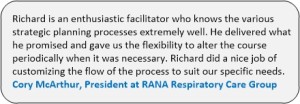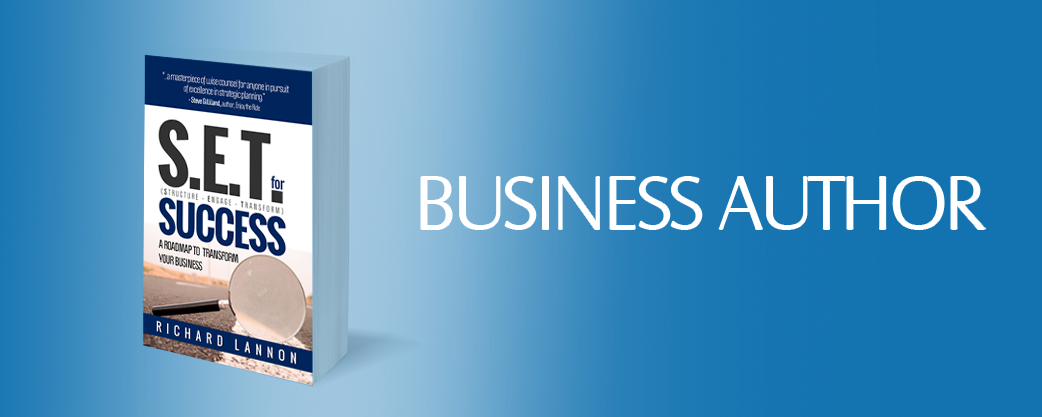 S.E.T. for Success, a Roadmap to Transform Your Business
S.E.T. for Success, a Roadmap to Transform Your Business
Steps to Create a Strategic Plan to Action Roadmap for Your Business
Ensuring the right approach to achieve the business objectives and transform your business
Strategy defines the most effective way to apply the capabilities of a business in order to reach its goals and objectives. Strategy can exist for the overall organization, at a number of different levels or areas within an organization or for a specific program or project.
Organizations can become stuck, lose focus and direction due to a number of factors internally and externally to the enterprise. Sometimes you are just trying to achieve more the same way. Maybe the business numbers are moving in one direction and the market and people are moving someone else. Other times it’s a rapid growth situation and there is business impact in all your key zones that need to be addressed. When the strategy is not aligned and there is no road map it becomes difficult to correct your course.
BraveWorld’s and Richard Lannon’s S.E.T. for Success approach helps organizations develop a clear picture of your present situation, your future business’ requirements and the transition approach needed to link the strategic agenda with key initiatives and work solutions to move forward.
PLEASE TELL ME, IN WHAT WAY CAN I HELP YOU
The S.E.T. for Success Approach
The S.E.T. approach is broken down into three key components; a structured approach to understand the business, the facilitation of planning sessions to ensure people are engaged in the process and the development of plans to ensure the business environment is transformed. It is the 1-2-3 of business strategic analysis, planning, implementation and transformation.

- Structure Your Approach: The best way to begin to understand your business problems and opportunities is through a structured analysis. This often involves a combination of interviews, questionnaires and assessments to get some benchmarks of where your business and its processes currently stand.
- Engage Your People: Your people are one of your greatest assets. It’s important to harness their knowledge and get them engaged in helping you understand your business and its challenges. This is often done through group meetings and facilitated workshops. The key is to let your people help you unravel complex issues and make key decisions.
- Transform Your Business: There are many aspects of transformation planning. In this case I’m referring to creating an strategy map, an actionable roadmap, work-plans and communication plans for your business environment. Whatever it takes for you and your people to actually take action and create change.
 The SET-Ability Model Revealed
The SET-Ability Model Revealed
One way to get your business back on track is to use a model with clear parameters and guidelines. The model we use is the “SET-Ability” model. By definition, the word ‘SET-Ability’ refers to the ability to fine-tune your business to achieve consistent, measurable results for positive business impact.
There are a number of factors that you can set within your business that will alter its performance in key business impact zones – business development, process and productivity, tools and technology and people and culture. Fine-tuning these impact zones will allow your business to work more efficiently and effectively, allowing you to get the best out of each different part of your business as well as the company as a whole.
What’s more, the SET-Ability model can be used at the strategic, tactical or operational level of planning for your business. Which means it can be used for an overall organization, a department or team, and even at the program and project levels.
The SET-Ability model as a whole is made up of impact zones, ripple effects and outcomes. You cannot push on one without impacting the others. For example, if we push on business development, it will ripple out into the other impact zones. Add additional clients and there is pressure on your business processes, the tools you use and the people and culture of your organization. Say that something needs to be done more quickly, and you create an acceleration effect. If you adjust how your work gets done with your people and company culture, you will impact process and productivity, and so on. It is like the stone thrown into a pond: one stone, one ripple; multiple stones, multiple colliding ripples and major business impact.
As you can see in the SET-Ability Model is broken down into key impact zones:

Stakeholders: Every business has both internal and external stakeholders, as well as positive and negative stakeholders. These can include investors, government agencies, competitors and/or employees. Understanding stakeholders and their impact on a business is an area where a lot of businesses miss the mark.
Organization, Teams and Individuals: Like a sports team, if these are working together well, then the business has a chance to be a champion. The idea is that everyone needs to be aligned to the common interests of the business.
Vision and Mission: Every business needs to have a vision and mission. Vision embraces the future success of your business. Mission clearly states what you are all about. This is an area which a lot of business leaders and their teams (and therefore their employees!) misunderstand, thinking it is merely fluff. If this is true of your organization, it can cause serious problems in alignment, purpose, and your overall success factor.
Values and Guiding Principles: True values are the core on which you build your company. Guiding principles are statements used to make business decisions.
Goals and Objectives: These are the things you want to achieve. Goals are overarching, while objectives are specific. Goals and objectives can be written and translated at the three main levels within your company – the strategic, tactical and operational.
Process and Productivity: This simply means the way we do our work. People complicate work processes and productivity-thinking all the time. This area is all about unraveling those complications and creating maximum efficiency and effectiveness.
Tools and Technology: Simply put, these are whatever we use to do our work. That can mean a tractor, car, computer or even a pen. Changes in tools and technology can create major impacts on your business.
 Business Development: The way we get our work. Whether you are a profit or non-profit organization, we all engage in the art of business development in order to stay afloat and keep wind in our sails.
Business Development: The way we get our work. Whether you are a profit or non-profit organization, we all engage in the art of business development in order to stay afloat and keep wind in our sails.
People and Culture: This is a combination of both the place we work and the resources we use to get our work done. It is another of the most often underestimated areas of impact.
Measurement: Understanding the common indicators that help guide business decisions. It is a matter of knowing the key measurements for your business and making sure you have the right indicators dialled in.
The key to the success of the S.E.T. Approach is the SET-ability Model outlined in the book S.E.T. for Success, a roadmap to transform your business by Richard Lannon.
TELL ME ABOUT YOUR BUSINESS NEED
Plan It – Map It – Implement It to Transform Your Business!
It is important that you get you outcomes and deliverables. A deliverable is something that is produced as the result of a project and delivered to customers, either internal or external. It can be tangible (i.e. a physical product) or intangible (i.e. a service). A good planning approach will yield concrete deliverables and clear outcomes.
An outcome is a positive change that results from a successful planning process. Every organization can benefit from some common deliverables using an approach that can help them clarify and achieve their outcomes. Some of the outcomes you should expect from the S.E.T. Approach using the SET-Ability Model include:
- Apply a systematic approach to strategic planning and implementation
- Create a strategy map outlining key business focus areas for your organization
- Establish leading and lagging indicators for your success measurements for key areas
- Build an implementation roadmap to guide your future success with strategic agenda, initiatives, champions and work solutions tied to timelines
- Create a communication matrix for your plan implementation to engage your people
- Establish your transformation management approach
- Build Team commitment for the things you must do through engagement in the process
- Go the distance through transformation implementation.
You Need to Go the Distance
 Developing a strategic plan and an actionable road map is a journey that the business leadership needs to take. It’s what provides you a deeper understanding of your business, its moving parts and the commitment needed to travel forward. Successful strategic planning leads to successful tactical and operational planning (in essence, implementation plans). Each level, as we discussed in this book, needs to be connected—the strategic, the tactical and the operational—and the only way to do that is to use a model that takes into consideration all the key impact zones of your business, as well as connecting stakeholder’s needs, vision and mission, values and guiding principles and goals and objectives with the work that needs to be done.
Developing a strategic plan and an actionable road map is a journey that the business leadership needs to take. It’s what provides you a deeper understanding of your business, its moving parts and the commitment needed to travel forward. Successful strategic planning leads to successful tactical and operational planning (in essence, implementation plans). Each level, as we discussed in this book, needs to be connected—the strategic, the tactical and the operational—and the only way to do that is to use a model that takes into consideration all the key impact zones of your business, as well as connecting stakeholder’s needs, vision and mission, values and guiding principles and goals and objectives with the work that needs to be done.
By using the SET Approach and the SET-Ability model you can focus on your whole organization or just one impact zone and create a business roadmap that will serve as a guide to your success. If you structure your approach and engage your people, you will transform your business. You will be SET for Success.
Contact Information
If you require any additional information or have questions, please connect 204-899-2808 or email to BraveWorld. CLICK TO TELL ME HOW WE CAN HELP








